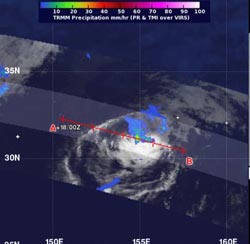NASA sees strong wind shear adversely affect Tropical Storm Maria

On Oct. 18 at 0845 UTC (4:45 a.m. EDT), NASA's TRMM satellite saw that rain associated with Tropical Storm Maria was limited to east of the storm's center, and was light to moderate (pictured in green and blue) and falling at a rate between .78 to 1.57 inches/20 to 40 mm per hour.<br><br>Credit: SSAI/NASA, Hal Pierce<br>
On Oct. 18 at 0845 UTC (4:45 a.m. EDT), NASA's Tropical Rainfall Measuring Mission (TRMM) satellite saw that rain associated with Tropical Storm Maria was limited to the east of the storm's center. Rainfall was also light to moderate, falling at a rate between .78 to 1.57 inches/20 to 40 mm per hour.
There were no areas of heavy rain remaining in the tropical cyclone. The low-level center of the storm is now exposed and a wind shear greater than 30 knots (34.5 mph/55.5 kph) continues to further weaken the storm.
At 1500 UTC (11 a.m. EDT) on Oct 18, Maria's maximum sustained winds were down to 35 knots (~40 mph/65 kph) and weakening. It was located near 31.9 North and 155.6 East, about 780 nautical miles east of Tokyo, Japan.
It was moving to the east and into the open waters of the northern Pacific at a speed of 14 knots (16 mph/26 kph).
By Oct. 19, the combination of the strong wind shear with cooler sea surface temperatures are expected to make Maria dissipate.
Media Contact
More Information:
http://www.nasa.govAll latest news from the category: Earth Sciences
Earth Sciences (also referred to as Geosciences), which deals with basic issues surrounding our planet, plays a vital role in the area of energy and raw materials supply.
Earth Sciences comprises subjects such as geology, geography, geological informatics, paleontology, mineralogy, petrography, crystallography, geophysics, geodesy, glaciology, cartography, photogrammetry, meteorology and seismology, early-warning systems, earthquake research and polar research.
Newest articles

Webb captures top of iconic horsehead nebula in unprecedented detail
NASA’s James Webb Space Telescope has captured the sharpest infrared images to date of a zoomed-in portion of one of the most distinctive objects in our skies, the Horsehead Nebula….

Cost-effective, high-capacity, and cyclable lithium-ion battery cathodes
Charge-recharge cycling of lithium-superrich iron oxide, a cost-effective and high-capacity cathode for new-generation lithium-ion batteries, can be greatly improved by doping with readily available mineral elements. The energy capacity and…

Novel genetic plant regeneration approach
…without the application of phytohormones. Researchers develop a novel plant regeneration approach by modulating the expression of genes that control plant cell differentiation. For ages now, plants have been the…





















